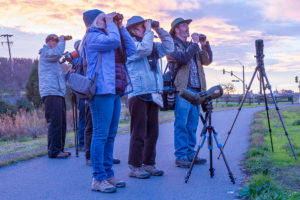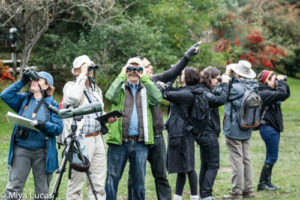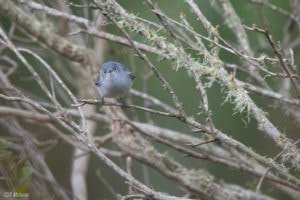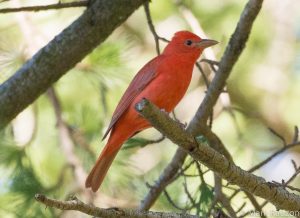Misses Marked 2018’s Oakland Christmas Bird Count
by Dave Quady and Bob Lewis
During the week preceding count day, forecasts of rain and high winds created a sense of
foreboding that continued into the early hours of Sunday, December 16, as early-rising
birders set out to seek owls. Along Telegraph Avenue few vehicles broke the silence and
ambient light bouncing off low clouds obviated the need for flashlights. Playing a bit of
tape elicited a single call from a distant Barn Owl. Moments later Berkeley’s City Bird
silently flew in and circled overhead, and so at 3:30 a.m. Oakland’s 78th annual Christmas
Bird Count got underway.

Thick cloud cover made dawn a non-event, but it nonetheless marked the usual ramp-up
of birding activity as teams met up in the field and began to bird their assigned areas.
Although winds gusted to 18 mph, the weather was mild during the morning:
temperatures in the 50 – 60 degree range, moderate winds and no rain. Our two boats
were able to get onto San Francisco Bay, 261 field observers provided good coverage
over the complete count circle and 34 yard watchers contributed mightily– producing, for
example, more than half of our record high 22 White-throated Sparrows. Rainfall began
about 2:15 pm, but by that time many teams had done their job, and by 3:00 p.m. most
folks had called it quits.
Our “good birds” of the day were a varied lot. They included single Long-tailed Ducks
from two different areas, a juvenile Ferruginous Hawk detected in two adjacent areas
(and chosen as the count’s Best Bird), 18 Snowy Plovers, 35 Surfbirds, a House Wren, a
Blue-gray Gnatcatcher, two Black-throated Gray Warblers (one reported by a yard
watcher) and a Western Tanager. Besides White-throated Sparrow, record-high numbers
(since 1974) were recorded for Cackling Goose, Green-winged Teal, Semipalmated
Plover, Great Blue Heron, White-tailed Kite, American Crow (2,486 birds) and Common
Raven (453 birds).

In recent years we’ve experienced a record-high count for one or the other of these two
corvids several times, so let’s examine their population trend. From 1974 through 1990
we averaged fewer than 200 total crows and ravens a year … over the following 10 years
we averaged more than 700 total crows and ravens annually, and since 2010 the annual
average has been nearly 1,800 birds. That has been quite a population increase, and
there’s no sign that it has topped out.

This year’s story, though, is not about high counts, either of species or of birds. It is
instead about misses – of birds and of species. We recorded lower numbers of birds in
most species groups (gulls being the main exception): 35% fewer ducks than the
preceding 10-year average, 30% fewer shorebirds and waders, 25% fewer finches and
sparrows, and 35% fewer warblers. Our total of 85,269 birds was nearly 12,000 below
our 10-year average.
These misses were not from lack of effort. Our 261 field observers spent very nearly the
same number of party-hours in the field than in the past 10 years (down only 3%). So the
birdwatchers were there, but the birds were not.

This year we recorded no white geese – Snow or Ross’s, no Bonaparte’s Gulls and no
Pine Siskins. Most years we record a few of each, and their absence might be attributable
to seasonal variation or the vagaries of winter migration. We also recorded no Redheads,
White-winged Scoters, Ruddy Turnstones, Red Knots, Loggerhead Shrikes or Tricolored
Blackbirds. These species are in a different category: Species present in small numbers
during most recent years, but declining range-wide and at risk of – or in the process of –
winking out in our area. Almost certainly habitat loss, within our count circle and/or in
other areas that the birds experience during their lifetimes, has played a big part in these
declines.
Perhaps the most galling misses are count week birds: species that were recorded within a
three-day span on either side of count day, but missed on count day. This year we had
five of them. Two – Common Gallinule and Rock Wren – have each been found in only
one or two locations within the count circle in recent years, and they can be elusive, as
they were this year. Luck happens.

This adult male Summer Tanager (photographed here on December 13) evaded detection on count day. Photo by Mark Rauzon
A juvenile Yellow-bellied Sapsucker found and photographed in Moraga on December 11 was
also seen on the next two days, but not subsequently. A lovely adult male Summer Tanager
found in Claremont Canyon on October 30 was missed for more than a month, then seen
again in early December, including on December 13. It continued at least through January 12,
but evaded us on count day. Finally, a male Black-headed Grosbeak, hanging out for its
fourth winter at feeders in Claremont Canyon, was seen on December 15, but not on count day.
In 2017 the Oakland Christmas Bird Count recorded more Band-tailed Pigeons, Spotted
Sandpipers, Western Gulls, Great Horned Owls, Hutton’s Vireos, Ruby-crowned
Kinglets and California Towhees (with 712) than any other count. 2018’s count recorded
many fewer of each of these species; we’ll have to wait until the fall to learn how well we
did compared with other counts. Most prominently among these species, we’ll await
word whether 2018’s 526 California Towhees were enough to retain the title we’ve held
every year since 2008: The California Towhee Capital of the World.

While it’s very gratifying to surpass other counts in the numbers of various bird species
they record, it’s far more important that our participants enjoy their experience, and come
back for the next year’s count. We are very proud that for four straight years – 2014
through 2017 – Oakland had more field observers than any other count in the world. We
hope that 2018’s 261 field observers extended our streak one more year.
We thank all who participated in this year’s count – especially our boat captains and area
leaders, as well as the folks who made the compilation dinner so enjoyable. And we hope
they will all return on December 15 for Oakland’s 79th count. We hope you’ll join us, too.

—————-
Bob and Dave have led the Claremont area of the Oakland CBC since the ‘70s. They
agreed to co-compile the count 16 years ago, but only if the other did at least half the
work. Happily, it’s worked out that way, including at their favorite part of the day: the
CBC Count Dinner.
MEDIA COVERAGE OF THE OAKLAND CBC
The December 21 edition of KQED Science provides a glimpse into the count. Listen at
https://www.kqed.org/science/1935746/your-guide-to-science-and-nature-events-this-
holiday-season
For a printable pdf of this report go HERE
